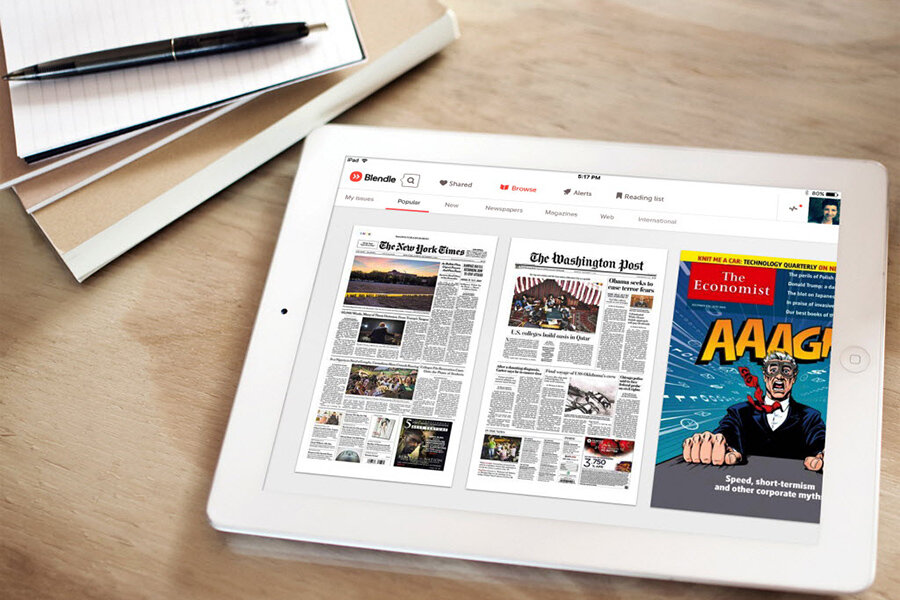In age of Spotify and Netflix, will readers pay for ad-free news stories?
Loading...
Blendle, a Dutch news aggregator, is offering readers irritated by news paywalls and web ads a novel solution — paying a small fee to read an individual article.
The à la carte news service, which is launching on Wednesday in the US, has secured partnerships with several prominent publications, including The Wall Street Journal, The New Yorker, The Economist, New York Magazine, and Bloomberg Businessweek.
The service has 650,000 users in Germany and the Netherlands. It offers ad-free reading for users that pay between $0.09 and $0.49 per article, at rates set by individual publishers. Users can receive a refund if they don’t like a story.
New readers are initially offered a $2.50 credit to begin using the app.
The average newspaper story may cost $0.40 while longer magazine stories could cost more, Bloomberg reports.
It’s part of a trend known as micropayments, one embraced by publishers who are concerned about how declining ad revenues — especially due to the growing use of online ad-blockers — are impacting their ability to produce content.
“The current model for monetizing journalism is broken,” Alexander Klöpping, Blendle’s co-founder, told tech site The Verge. “Young people are resistant to subscribing to newspapers and magazines, ad revenue is declining and ad blockers are putting extreme pressure on publishers. In Europe, we’ve proven that there’s a real need for one account to discover the best journalism.”
But in the age of subscription-based services for streaming movies, TV, and music such as Netflix and Spotify, it seems to be an open question — will users embrace the model of paying per article?
“Putting micropayments on news is like putting tollbooths on an open ocean,” wrote Marshall W. Van Alstyne, chair of the information systems department at Boston University’s Questrom School of Business, in a 2009 blog post examining the trend. “News is not like an iTunes song; it’s perishable. Today’s front page is tomorrow’s fish wrap and we don’t need to replay it."
Blendle dubs itself the “iTunes of journalism,” though the Apple-branded store itself launched a subscription service, Apple Music, in July 2015, growing rapidly to 11 million subscribers in February.
It’s billing the service as a more customized option, especially for younger readers used to consuming news online.
“You still need to register at every newspaper or magazine you want to read while paying monthly fees for every site or for a bundle of articles with all kinds of stuff you don’t read,” the app’s site says. “The editors still make a non-personalized selection for you, and every newspaper has its own website.”
So far, Blendle appears to be most popular with publishers concerned about the impact of declining ad revenue. In 2014, The New York Times Co. and German media conglomerate Axel Springer invested $3.7 million in the startup.
The publishers particularly pointed to the challenges of encouraging a younger, Internet-savvy audience to pay for their content.
As of October 2014, 20 percent of Blendle’s 130,000 users in the Netherlands (the number has since grown) had added funds to their accounts on the app after a free trial of the service, The Wall Street Journal reported.
There are also distinctions between the US and Europe. While many news sources are still available for free online in the US, many European publications have increasingly put much of their content behind a paywall.
Blendle’s refund option is also controversial, both with publishers concerned about the impact of refunding money to customers if they don’t like an article and with people concerned about its impact on the media business.
“Unlike iTunes, for example, which benefits from a legal regime designed to prevent sharing, discussion of events in the real world can’t be kept from circulation,” wrote Clay Shirky, an associate professor at New York University and who has often written about media and the Internet. “Publishers have been telling each other for years that eventually people will tire of being able to produce and share amateur content, rather than just consuming professional content, but the users don’t seem to have gotten that memo."
But for publishers concerned about the impact of declining ad revenue – the potential to gain even a small group of users through the new app is worth it.
“If a customer chooses to buy just one article a day from The Wall Street Journal,” Katie Vanneck-Smith, the chief customer officer for Dow Jones, which owns the Journal, told the Associated Press, “then I'm happy they're choosing to do that.”





